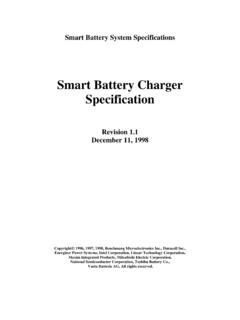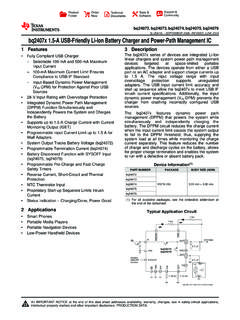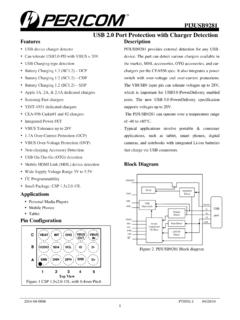Transcription of System Management Bus Specification
1 Smart Battery System Specifications System Management Bus Specification Revision December 11, 1998. 1996, 1997, 1998, Benchmarq Microelectronics Inc., Duracell Inc., Copyright . Energizer Power Systems, Intel Corporation, Linear Technology Corporation, Maxim Integrated Products, Mitsubishi Electric Corporation, National Semiconductor Corporation, Toshiba Battery Co., Varta Batterie AG, All rights reserved. System Management Bus Specification Questions and comments regarding this Specification For additional information on Smart may be forwarded to: Battery System Specifications, visit the Email: SBS Implementer's Forum (SBS-IF) at: Or: THIS Specification IS PROVIDED "AS IS" WITH NO WARRANTIES WHATSOEVER, INCLUDING ANY WARRANTY OF MERCHANTABILITY, NONINFRINGEMENT, FITNESS FOR ANY.
2 PARTICULAR PURPOSE, OR ANY WARRANTY OTHERWISE ARISING OUT OF ANY PROPOSAL, Specification OR SAMPLE. THE AUTHORS DISCLAIMS ALL LIABILITY, INCLUDING. LIABILITY FOR INFRINGEMENT OF ANY PROPRIETARY RIGHTS, RELATING TO USE OF. INFORMATION IN THIS Specification . NO LICENSE, EXPRESS OR IMPLIED, BY ESTOPPEL OR. OTHERWISE, TO ANY INTELLECTUAL PROPERTY RIGHTS IS GRANTED HEREIN. IN NO EVENT WILL ANY Specification CO-OWNER BE LIABLE TO ANY OTHER PARTY FOR. ANY LOSS OF PROFITS, LOSS OF USE, INCIDENTAL, CONSEQUENTIAL, INDIRECT OR SPECIAL.
3 DAMAGES ARISING OUT OF THIS AGREEMENT, WHETHER OR NOT SUCH PARTY HAD. ADVANCE NOTICE OF THE POSSIBILITY OF SUCH DAMAGES. FURTHER, NO WARRANTY OR. REPRESENTATION IS MADE OR IMPLIED RELATIVE TO FREEDOM FROM INFRINGEMENT OF. ANY THIRD PARTY PATENTS WHEN PRACTICING THE Specification . SBS Implementers Forum Page ii Version System Management Bus Specification Table of Contents 1. OVERVIEW ..6. What is System Management Bus?.. 6. Audience .. 6. Scope .. 6. Supporting Documents .. 7. 2. GENERAL CHARACTERISTICS ..8. 3. BIT TRANSFERS.
4 10. Data validity .. 10. Start and Stop 10. 4. DATA TRANSFERS ON Byte 11. Acknowledge (ACK) and not acknowledge (NACK) .. 11. 5. ARBITRATION AND CLOCK GENERATION ..13. Synchronization .. 13. 13. Clock low 14. 6. DATA TRANSFER FORMATS ..16. 7. PROTOCOL ..17. Usage Model .. 17. Device Identification -- Slave 17. SMBus address 18. Using a Device .. 18. Packet Error 19. Packet Error Checking 19. Packet Error Code calculation by 19. SBS Implementers Forum Page iii Version System Management Bus Specification Bus Protocols.
5 20. Quick Command .. 20. Send Byte .. 20. Receive Byte .. 21. Write 22. Read 22. Process 23. Block 25. Communicating with the Host .. 27. Reporting 28. 8. ELECTRICAL CHARACTERISTICS OF SMBUS DEVICES ..29. AC Specifications .. 29. General timing conditions .. 30. Timeouts .. 30. Slave device timeout definitions and conditions .. 31. Master device timeout definitions and 31. DC Specifications .. 32. 32. SMBus branch Circuit 33. APPENDIX A: OPTIONAL SMBUS SMBSUS# .. 34. SMBALERT#.. 35. APPENDIX Main Differences Between System Management Bus and I2C.
6 37. DC Specifications for SMBus and I2C .. 37. Timing specifications differences of I2C and SMBus .. 38. Other 38. APPENDIX C: SMBUS DEVICE ADDRESS SBS Implementers Forum Page iv Version System Management Bus Specification Revision History Revision Number Date Notes 2/15/95 General Release 12/11/98 Version Release SBS Implementers Forum Page v Version System Management Bus Specification 1. Overview What is System Management Bus? The System Management Bus (SMBus) is a two-wire interface through which simple System and power Management related chips can communicate with the rest of the System .
7 It is based on the principals of operation of I C. SMBus provides a control bus for System and power Management related tasks. A System using SMBus passes messages to and from devices instead of tripping individual control lines. Removing the individual control lines reduces pin count. Accepting messages ensures future expandability. With System Management Bus, a device can provide manufacturer information, tell the System what its model/part number is, save its state for a suspend event, report different types of errors, accept control parameters, and return its status.
8 The System Management Bus may share the same host device and physical bus with I C components provided that the electrical and timing specifications of this document are adhered to. Intel conceived the System Management Bus originally, as the communication bus to accommodate Smart Batteries and other System and power Management components. In 1994 SMBus became part of the On- board specifications. In January 1995 Philips announced in New York the royalty free status of devices including On-board compliant devices. In 1996 the Smart Battery System specifications were handed by Intel and Duracell to a group of 10 companies that formed the core group of the SBS.
9 In 1997 the SBS Implementers Forum was formed and SMBus became part of the specifications handled by this group. The same year SMBus was incorporated into the ACPI specifications as the bus to communicate with the Smart Battery System and other System components, such as temperature sensors, etc. ACPI specifications also defined the SMBus host interface to the OS. Audience The target audience for this document includes: System designers implementing the System Management Bus Specification in their systems VLSI engineers designing chips to connect to the System Management Bus Software engineers writing support code for System Management Bus chips Scope This document describes the communications protocols available for use by devices on SMBus.
10 Its original purpose was to define the communication link between an intelligent battery, a charger for the battery, and a microcontroller that communicates with the rest of the System . However, it can also be used to connect a wide variety of power-related devices. The Specification allows for multiple devices to attach to the System Management Bus. Information is exchanged through a simple index set specific to each device. The SMBCLK and SMBDATA pins are similar to the clock and data pins found on an I C bus. The SMBus electrical characteristics differ from those of I C.









